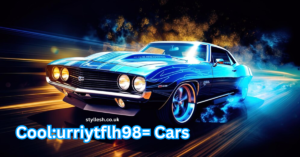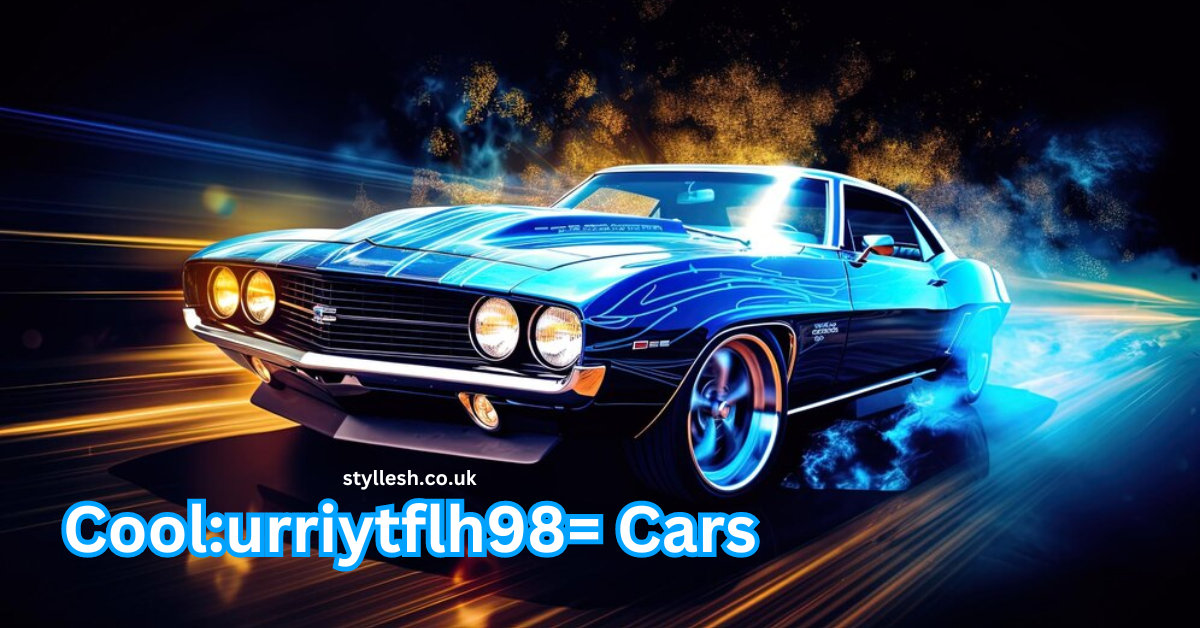
Explore the journey of Cool:urriytflh98= Cars, from muscle cars to electric vehicles, and how they blend speed, style, and innovation to define automotive excellence.
Table of Contents
ToggleIntroduction
Cool:urriytflh98= Cars have always captivated automotive enthusiasts with their combination of speed, style, and innovation. From the roaring engines of muscle cars to the sleek, futuristic design of electric vehicles, cool cars reflect the changing landscape of technology and culture. As the automobile industry continues to evolve, cool cars remain at the forefront, representing not only a mode of transportation but a statement of personality and sophistication. With a rich history rooted in performance, these vehicles have become icons that inspire passion among drivers worldwide. Their ability to merge performance with design makes cool cars an enduring symbol of automotive excellence.
The Early Days of Cool:urriytflh98= Cars
In the early days of the automobile industry, cool cars were defined by their mechanical ingenuity and the excitement of owning a machine that could go faster than a horse-drawn carriage. The Model T, introduced by Ford in 1908, was one of the first vehicles to capture the public’s imagination. While it was designed for mass production and affordability, it represented a major leap in what cool cars would become. Even at that time, the idea of customizing and upgrading a car was born, setting the foundation for car culture as we know it today.
The Rise of Muscle Cars
By the mid-20th century, the definition of cool cars shifted with the rise of muscle cars. In the 1960s and 1970s, cars like the Ford Mustang, Chevrolet Camaro, and Dodge Challenger became symbols of power and freedom. With their massive engines, bold designs, and the roar of the exhaust, muscle cars represented the peak of automotive coolness. These cars were not just about getting from point A to point B; they were about the journey and making a statement on the road. The appeal of these cool cars extended beyond speed, as they embodied an attitude and a lifestyle of rebellion and independence.
The Influence of European Sports Cars
As American muscle cars dominated the streets, European manufacturers brought their own flair to the world of cool cars with sleek, high-performance sports cars. Brands like Ferrari, Lamborghini, and Porsche introduced vehicles that prioritized not only speed but also aesthetics and luxury. The Ferrari 250 GTO and Lamborghini Miura are prime examples of European craftsmanship that blended power with elegance. These cars weren’t just built for the track; they were designed to turn heads on any street. Their precise engineering and sophisticated designs further defined what cool cars could be, offering a blend of luxury and performance that still holds immense appeal.

The Era of Supercars
The 1980s and 1990s marked the arrival of supercars, which took the concept of cool cars to new heights. Supercars like the McLaren F1, Ferrari F40, and Lamborghini Countach pushed the boundaries of speed, aerodynamics, and futuristic designs. These cool cars were designed to be faster than any vehicle on the road, with top speeds that defied expectations. However, it wasn’t just about the speed; these vehicles were feats of engineering, showcasing cutting-edge technology and design elements that made them aspirational symbols for car enthusiasts. The allure of supercars continues today, with models like the Bugatti Chiron setting new standards for what cool cars can achieve.
Cool Cars in Pop Culture
Cool:urriytflh98= Cars have also carved out a significant place in pop culture. From James Bond’s Aston Martin to the DeLorean in Back to the Future, these cars are often as iconic as the characters that drive them. Movies and TV shows have cemented the status of certain cars as symbols of style, sophistication, and adventure. Whether it’s the sleek Batmobile or the instantly recognizable Chevrolet Impala from Supernatural, cool cars have a way of captivating audiences and becoming a crucial part of storytelling. These vehicles go beyond their role in real life, serving as symbols of freedom, power, and mystery in entertainment.
The Advent of Electric Cool Cars
In recent years, the definition of cool cars has undergone a transformation with the rise of electric vehicles (EVs). Brands like Tesla have disrupted the market by combining environmental sustainability with the high-tech innovation that defines cool cars. The Tesla Model S, for example, has garnered praise for its sleek design, impressive performance, and cutting-edge technology. Other manufacturers, like Porsche with the Taycan, have also embraced electric powertrains without sacrificing the luxury and performance expected from cool cars. As EV technology continues to evolve, the notion of cool cars is expanding to include vehicles that are not only fast and stylish but also eco-friendly.
Luxury Meets Technology
Cool:urriytflh98= Cars today are not only about aesthetics and speed; they are also packed with the latest technology. Features like autonomous driving, advanced infotainment systems, and cutting-edge safety measures have redefined the driving experience. Brands like BMW, Mercedes-Benz, and Audi are at the forefront of integrating these technologies into their vehicles, ensuring that cool cars are as smart as they are stylish. These innovations allow drivers to enjoy a more seamless and comfortable ride while also emphasizing safety and convenience. The blending of luxury and technology is key to the modern cool car’s appeal, making these vehicles desirable for more than just their exterior.
Customization and the Personal Touch
One of the most exciting aspects of owning cool cars is the ability to customize them according to personal preferences. Whether it’s upgrading the engine for better performance, modifying the interior for luxury, or giving the exterior a unique look, car customization has become an integral part of automotive culture. This personal touch allows cool cars to be a reflection of the owner’s personality, further enhancing the emotional connection between the driver and the vehicle. Aftermarket modifications, including custom paint jobs, performance upgrades, and unique body kits, have become a thriving industry, allowing cool cars to be as individual as their owners.

Cool Cars and Sustainability
Sustainability is becoming an increasingly important factor in the design and production of cool cars. With the automotive industry facing pressure to reduce emissions and create more environmentally friendly vehicles, many manufacturers are focusing on producing electric and hybrid models. Tesla, for instance, has set the standard for cool electric cars with its sleek designs and impressive performance. Additionally, brands like Jaguar and BMW have introduced electric versions of their iconic models, proving that sustainability can go hand-in-hand with the performance and luxury that defines cool cars. The shift towards greener vehicles is a key trend in the evolving landscape of cool cars.
The Appeal of Classic Cool Cars
While new models continue to push the boundaries of automotive technology, classic cool cars remain as desirable as ever. Cars like the 1967 Shelby GT500 or the 1957 Chevrolet Bel Air have earned their place in automotive history, not just for their performance but for their timeless design and cultural impact. Owning a classic cool car is a way to connect with the past while still enjoying the thrill of the open road. These vehicles evoke a sense of nostalgia and are often cherished for their craftsmanship and iconic status. For many enthusiasts, classic cool cars represent the golden age of motoring.
The Impact of Cool Cars on Automotive Design
Cool:urriytflh98= Cars have always had a significant influence on the overall direction of automotive design. Whether it’s the sleek lines of a Ferrari or the bold stance of a Dodge Charger, cool cars often set the trends that shape the broader market. Designers draw inspiration from these vehicles, incorporating elements like aggressive aerodynamics, advanced lighting systems, and futuristic interiors into mainstream cars. The result is a ripple effect where cool cars push the industry forward, creating a future where cutting-edge design is more accessible to a wider audience. This influence ensures that cool cars remain at the forefront of automotive innovation.
Cool Cars and Motorsport
Motorsport has always been closely linked to the development and appeal of cool cars. Vehicles that perform well on the track often serve as the foundation for street-legal versions that capture the imagination of car enthusiasts. Brands like Ferrari, Porsche, and McLaren have all made their mark in racing, and their victories on the track have translated into the desirability of their road cars. The connection between motorsport and cool cars is a symbiotic one, where performance enhancements developed in racing eventually make their way into consumer models, further cementing the status of these vehicles as the epitome of cool.
The Role of Cool Cars in Car Shows and Expos
Car shows and expos are some of the best places to see cool cars in action. Events like the Geneva Motor Show, SEMA, and the Pebble Beach Concours d’Elegance showcase the latest and greatest in automotive design and innovation. These events allow manufacturers to debut new models, reveal concept cars, and highlight advancements in automotive technology. For car enthusiasts, these shows are an opportunity to get up close and personal with some of the coolest cars in the world. The excitement generated by these events often sets the tone for the upcoming year in the automotive world, making them a vital part of car culture.

The Connection Between Cool Cars and Fashion
Cool cars have always had a strong connection to the world of fashion. Luxury brands like Gucci, Prada, and Louis Vuitton often collaborate with car manufacturers to create special edition models that reflect high-end design sensibilities. These collaborations elevate cool cars to the status of fashion statements, blending automotive excellence with luxury lifestyle brands. Whether it’s a limited-edition Bentley adorned with high-fashion touches or a Lamborghini with custom leather interiors, the intersection of fashion and cool cars continues to grow. This partnership highlights how cool cars transcend their role as vehicles, becoming symbols of style and sophistication.
The Role of Cool Cars in Social Media
In the age of social media, cool cars have found a new platform for showcasing their appeal. Instagram, YouTube, and TikTok are filled with car enthusiasts sharing their passion for cool cars, from behind-the-scenes restoration projects to thrilling test drives of the latest supercars. Influencers and automotive content creators have built large followings by sharing their experiences with cool cars, further expanding the reach and influence of these vehicles. Social media has allowed car culture to flourish in the digital space, where cool cars are celebrated, critiqued, and shared with a global audience.
Why Cool Cars Will Always Be Iconic
The enduring appeal of cool cars lies in their ability to capture the imagination. Whether it’s the sound of a roaring engine, the sleek lines of a body kit, or the thrill of speeding down an open highway, cool cars provide an experience that goes beyond transportation. They are symbols of freedom, power, and creativity, offering drivers a chance to express themselves through their choice of vehicle. As technology continues to evolve, cool cars will remain a constant, adapting to new trends while maintaining the timeless qualities that have made them iconic for decades.
Conclusion
Cool:urriytflh98= Cars have continuously evolved, merging speed, innovation, and style. From classic muscle cars to cutting-edge electric vehicles, they remain iconic symbols of freedom and creativity. As technology advances, cool cars will continue to inspire and captivate, defining the future of automotive excellence and culture.
Read Also: Mastering the Art of Sketch:o9aveqjnvau= Girl Drawing





